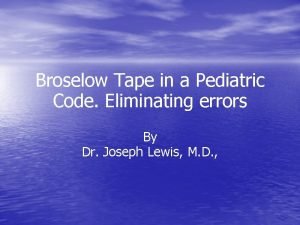88 The Videography In Pediatric Emergency Resuscitation VIPER

- Slides: 1

88 The Videography In Pediatric Emergency Resuscitation (VIPER) Collaborative: Simulation to Assess Feasibility and Reliability of a Video-based Resuscitation Registry Ben T. Kerrey 1, Karen J. O'Connell 2, Sage R. Myers 3, Allison L. Mak 3, Aaron J. Donoghue 3, 4 1 Division of Emergency Medicine and the Center for Simulation and Research, Cincinnati Children's Hospital Medical Center, Cincinnati, OH, 2 Division of Emergency Medicine, Children's National Medical Center, Washington, D. C. , 3 Division of Emergency Medicine and 4 Critical Care Medicine, Children’s Hospital of Philadelphia, PA, USA TAKE HOME: A video-based data registry developed through simulated resuscitations in a pediatric ED is generally feasible and reliable. • Prospective, observational study • Simulated pediatric resuscitations in a PED o Existing resident education curriculum • Three VIPER PEDs: resuscitation equipped with digital cameras/microphones Background Studies of resuscitative care in an emergency department (ED) are limited by single center nature (limited power and generalizability) and standard methods of data collection (chart review, self-report). We developed a multicenter, video-based collaborative (VIPER) to facilitate high quality clinical research and quality improvement initiatives Objective To determine the feasibility and reliability of the VIPER registry using multi-rater video review of in situ simulations Results Methods Next Steps • 3 simulations reviewed • Feasibility (178 data fields) o 4% indeterminate (67 of 1, 602 fields among 3 simulations and 3 reviewers) • Reliability (Table) measures high o except primary survey 5 • VIPER registry drafted by expert consensus and refined via iterative process o Data fields: our studies/AHA guidelines • 4 main domains for data field: 1. Monitors and vitals 2. Primary survey 3. Basic interventions 4. Tracheal intubation • 3 investigators independently reviewed simulations of pediatric resuscitation • Analysis o Feasibility: indeterminate fields (%) o Reliability: weighted Cohen’s kappa and intra-class correlation coefficients Table Dichotomous Fields All Monitors and vital signs Primary Survey Basic Interventions Tracheal Intubation Continuous fields All 95% CI = (0. 98, 1. 0); ICC = intra-class coefficient a k 0. 83 0. 93 0. 48 0. 84 0. 96 ICC 0. 99 a 1. Refine 1◦ survey fields 2. Add CPR and teamwork 3. Validate for actual pts 4. Add centers GOAL: create opportunities to conduct robust research on rare pediatric resuscitation events and evaluate needed interventions to improve care and outcomes for a vulnerable population Acknowledgements The authors thank the Zoll Foundation and their respective Divisions of PEM for their support of this research

